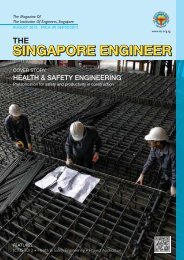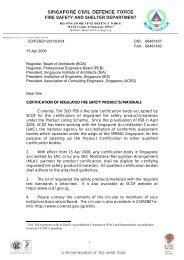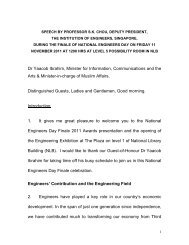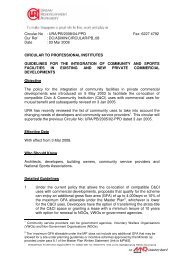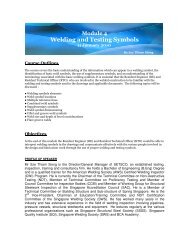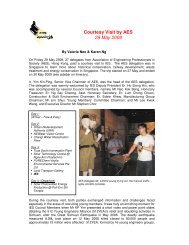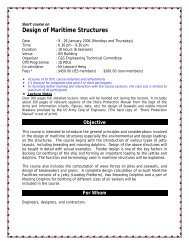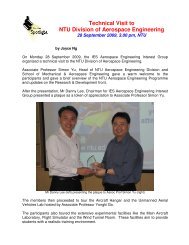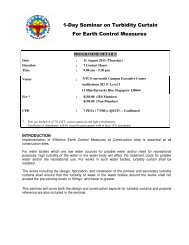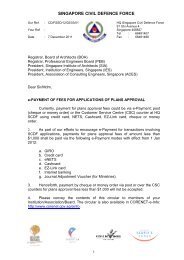THE SINGAPORE ENGINEER - Institution of Engineers Singapore
THE SINGAPORE ENGINEER - Institution of Engineers Singapore
THE SINGAPORE ENGINEER - Institution of Engineers Singapore
You also want an ePaper? Increase the reach of your titles
YUMPU automatically turns print PDFs into web optimized ePapers that Google loves.
AEROSPACE COVER <strong>ENGINEER</strong>ING<br />
STORY<br />
A*STAR showcases 15 innovative solutions<br />
At <strong>Singapore</strong> Airshow 2012, the Agency for Science, Technology and Research (A*STAR)<br />
showcased 15 cutting-edge technologies to boost safety and productivity in the aerospace<br />
industry. This is another good example <strong>of</strong> how A*STAR’s R&D capabilities, in partnership<br />
with those <strong>of</strong> companies, can bring economic value to <strong>Singapore</strong>.<br />
Showcased by A*STAR’s seven science and engineering<br />
research institutes, the advanced technologies come under four<br />
key areas - Airframe; Maintenance, Repair and Overhaul (MRO);<br />
Electronics and Communications; and Aviation Logistics.<br />
AIRFRAME<br />
Sonic Non-Destructive Testing (NDT) technique<br />
With the increased use <strong>of</strong> composite materials in aircraft<br />
construction, the non-destructive inspection <strong>of</strong> adhesivelybonded<br />
structures is increasing for aircraft maintenance and<br />
repair. Defects encountered at the interfaces <strong>of</strong> adhesivelybonded<br />
joints, such as disbond and delamination, can impair the<br />
strength <strong>of</strong> the structure. Therefore, such structures are inspected<br />
non-destructively in production and maintenance before they<br />
are used in the aircraft. The ultrasonic testing technique is<br />
predominantly used for testing the defects. Even though the<br />
existing test equipment has benefitted from advances in digital<br />
technology, it has yet to provide comprehensive evaluation<br />
for a wide range <strong>of</strong> defects. Also, in most cases, rather than<br />
indicating pass or fail, the defect severity in the structures needs<br />
to be assessed. Knowing the type, size and depth <strong>of</strong> defects will<br />
provide the important information in the mechanical strength<br />
and quality assessment <strong>of</strong> the composite materials.<br />
A*STAR’s <strong>Singapore</strong> Institute <strong>of</strong> Manufacturing Technology<br />
(SIMTech) has developed a sonic Non-Destructive Testing<br />
(NDT) technique that uses a frequency lower than half that<br />
<strong>of</strong> conventional ultrasonic techniques. Unlike the time-<strong>of</strong>-flight<br />
parameter used in traditional techniques for flaw detection,<br />
the material to be inspected is excited with certain waveform<br />
patterns and processes the excitation response in several ways<br />
to extract defect signatures. The key features are its capability to<br />
detect, learn and identify the structural defects such as disbond,<br />
delamination, and crushed core in the composite honeycomb<br />
structures. An additional feature <strong>of</strong> the system is the capability <strong>of</strong><br />
scanning the inspection area to generate a C-scan type <strong>of</strong> image<br />
with the defect type displayed. The system is tested on nonstructural<br />
defects such as incipient heat damage in composite<br />
laminates and water ingress in the honeycomb core.<br />
Fast-curing technology for aerospace sealants and<br />
adhesives<br />
Short curing time is a very important technical specification<br />
for adhesives and sealants. It can reduce the turnaround<br />
time for airplanes that need repairing and thus reduce the<br />
operation cost. Fast-curing technology aims to develop a curing<br />
technology for sealants which are used to repair fuel leaks, install<br />
windshields and windows, and seal out moisture. It usually takes<br />
a few days for existing sealants to achieve a full cure at room<br />
temperature. Thus a curing technology is urgently required with<br />
no operational hazards, to significantly reduce the curing time, in<br />
order to improve productivity.<br />
Using short wave IR radiation, A*STAR’s Institute <strong>of</strong> Materials<br />
Research and Engineering (IMRE) has developed a curing<br />
technology with no significant performance hazards. With this<br />
novel technology, the IR radiation can penetrate more deeply<br />
into materials and ensure more uniform curing through heating<br />
than medium wave IR radiation which is absorbed mostly in<br />
the outer surface <strong>of</strong> the materials. The short wave IR curing<br />
technology can greatly reduce the curing time from seven days<br />
to 1 - 2 hours without compromising the ultimate mechanical<br />
and thermal properties <strong>of</strong> the sealants and adhesives.<br />
Fast-curing technology for aerospace sealants and adhesives.<br />
Sonic Non-Destructive Testing (NDT) technique for detecting defects in<br />
composite structures.<br />
Nanoparticle-enhanced erosion resistant coatings<br />
Airplanes are exposed to severe external environmental stress<br />
while in flight, which is caused by high kinetic energy particles<br />
such as rain and dust, impacting on the leading edge <strong>of</strong> the airfoil.<br />
Currently, polymeric coatings are widely used to protect the<br />
airfoil structure. However, these coatings have poor durability<br />
18 <strong>THE</strong> <strong>SINGAPORE</strong> <strong>ENGINEER</strong> April 2012



